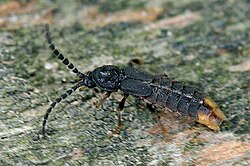| Phosphaenus | |
|---|---|
 | |
| Scientific classification | |
| Domain: | Eukaryota |
| Kingdom: | Animalia |
| Phylum: | Arthropoda |
| Class: | Insecta |
| Order: | Coleoptera |
| Suborder: | Polyphaga |
| Infraorder: | Elateriformia |
| Family: | Lampyridae |
| Subfamily: | Lampyrinae |
| Tribe: | Photinini |
| Genus: | Phosphaenus Fourcroy, 1785 |
| Species: | P. hemipterus |
| Binomial name | |
| Phosphaenus hemipterus (Geoffroy, 1762) | |
Phosphaenus hemipterus, [1] the short-winged firefly or lesser glow worm, is a beetle in the monotypic genus Phosphaenus and the family Lampyridae. It is found in the Mediterranean, in Central Europe, west to the Atlantic Ocean and north to the edge of Scandinavia and in England. In North America, the species has been introduced. It inhabits meadows, floodplains, forest edges, and dry slopes, but also parks and gardens. In Britain, this species is fairly rare compared to the common glow-worm ( Lampyris noctiluca ).